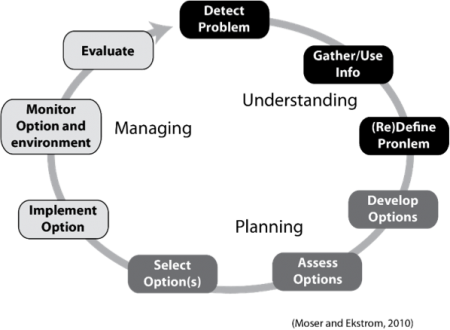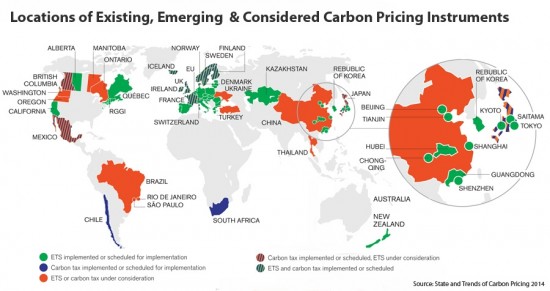December 13, 2015 – With the nations of the world in unanimous agreement to keep global warming below 2.0 Celsius (3.6 Fahrenheit) and strive to go no higher than 1.5 Celsius (2.7 Fahrenheit) an outcomes and adjustment mechanism is implied in the wording around facilitating implementation and compliance. To read the final draft of the 31-page document I have provided the link here. Discussion on facilitation begins on Page 14.
Successful business always knows how to adapt. Look at companies like Fujifilm and compare them to Kodak. Fuji was in the photography business and so was Kodak. The latter today is bankrupt while the former applied adaptive management strategies, rethinking what was behind the film business and turning it into the company’s newfound core strength. That identified strength was in chemicals and photosensitive materials and today Fujifilm is into cosmetics and medical-imaging.
Adaptive management is critical to survival. It’s about applying science and the scientific method to the monitoring of outcomes and then learning, adapting, re-evaluating and adjusting. It is by this method applied diligently by all nations party to the climate agreement that targeted reductions in greenhouse gas emissions can be reached on a global scale.
In a paper published in August 2015 in Nature Climate Change, researchers from University of Oxford in the United Kingdom, and Victoria University of Wellington, New Zealand, advocate for just such an approach and it appears that the world’s leaders have been listening. In their paper Friederike Otto, David Frame, Alexander Otto and Myles Allen argue that only a process of experimentation and assessment will achieve climate stabilization at or around 2 Celsius above pre-industrial levels. They talk about a “pledge and review” approach, learning from trial and error. The researchers recommend establishing an index of warming that could be updated annually and that could be used as the measure for review in ensuring that what each government is trying results in mitigating climate change impacts. Thus policy implementation is measurable against policy goal. States David Frame, “The creation of an agreed index of global warming would be a useful tool to assist policymakers work out where we are in terms of achieving the main aims for climate policy…..As we know from inflation-targeting and other aspects of health, social and environmental policy, indexing can help governments by reducing the opportunity for diversionary arguments based on the selective use of data.”
A good example of diversionary arguments leading to potential misdirected policy follows. Recently some governments have raised the issue of methane emissions as being almost as critical as carbon dioxide (CO2) in battling global warming. The scientific reality, however, shows methane is a red herring when attempting to limit peak warming to 2 Celsius or less. That’s because methane only has a short-term impact in contributing to warming in the atmosphere, whereas CO2 as an agent for warming is a long haul player. In research on adaptive management Frame points this example out stating, “as long as carbon dioxide emissions are not falling, methane emissions can have little impact on the overall magnitude of warming.” Therefore policy focused on methane and taken away from CO2 emissions, the prime agent of climate change would take away from achieving the goal of no more than a 2 Celsius warming upper limit.
Another observation talks about the cost of procrastination. The lack of action by governments between Copenhagen in 2009 and today has cost all of us. That delay of just over 5 years has resulted in a 0.2 Celsius increase in warming. The warming, directly attributable to the rate of increase in CO2 emissions at almost 2% per year, has lagged the growth in the greenhouse gas, but nevertheless the two are in lockstep. If you don’t understand the correlation consider something you can observe in the annual change of seasons. What happens to the atmosphere after the Sun reaches its position at winter solstice? The month in which it happens when the amount of solar energy striking the Earth’s surface is at its least is never the coldest month. Rather peak cold follows 30 to 60 days later. That’s the latency effect at work and CO2 and temperature rise are subject to the same science.
In an article appearing in the MIT Technology Review, author Richard Martin describes the research done by Frame and his colleagues as a framework for saving the planet. I heartily agree and it seems the COP21 negotiators in Paris appear to be on the same page because the language of the agreement reflects adaptive management principles, “the sharing of best practices on mitigation and adaptation in a holistic and integrated manner……including tools such as…carbon pricing.”
On the issue of carbon pricing, the agreement doesn’t go that far even though environmental scientists believe it is the best tool in our arsenal to begin the process of CO2 emission reduction. By necessity carbon pricing may follow COP21 as parties to the agreement adopt shared best practices. There are already examples of this type of cooperation. In the week prior to the release of the final agreement, the province of Manitoba in Canada joined the carbon market established by Quebec and California, a market that Ontario has agreed to join beginning in 2016. That now means more than 70% of Canada’s sub-jurisdictions have some form of carbon pricing. Before the Paris meeting 40 countries and 20 cities, states and provinces were in the carbon tax or trading business. Now there are 41 and I dare say that we shall see many more in the months to come filling the world map exhibit below with colour. Why? Because carbon pricing is the best adaptive management policy yet conceived for adjusting global human behavior in the transition to a net zero carbon future.










